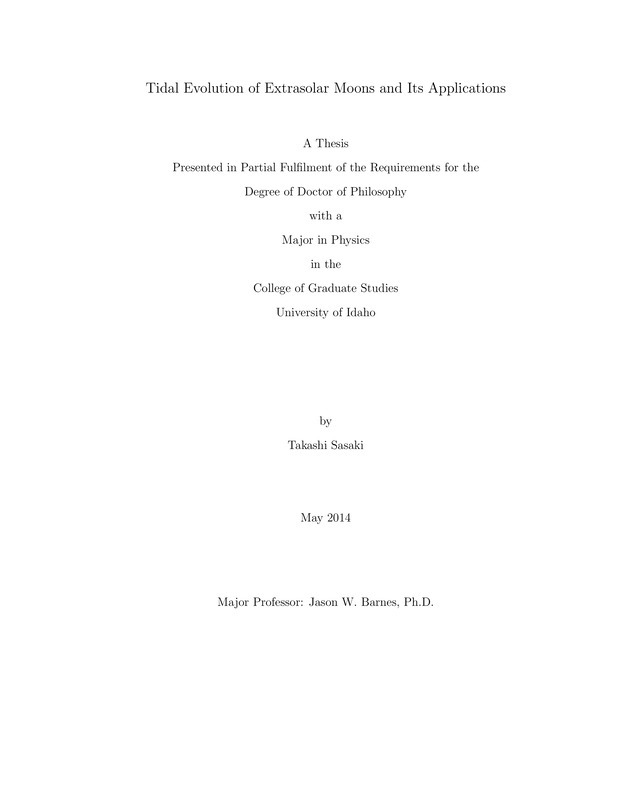Tidal Evolution of Extrasolar Moons and Its Applications
Sasaki, Takashi. (2014). Tidal Evolution of Extrasolar Moons and Its Applications. Theses and Dissertations Collection, University of Idaho Library Digital Collections. https://www.lib.uidaho.edu/digital/etd/items/sasaki_idaho_0089e_10163.html
- Title:
- Tidal Evolution of Extrasolar Moons and Its Applications
- Author:
- Sasaki, Takashi
- Date:
- 2014
- Program:
- Physics
- Subject Category:
- Physics; Astrophysics
- Abstract:
-
In this thesis, we consider tidal evolution of extrasolar moons of star-planet-moon systems.
First, we formulated tidal decay lifetimes for hypothetical moons with both lunar and stellar tides.
We found four types of trajectories depending on the astronomical parameters and the initial conditions.
For each type, we derived a formula that can calculate the lifetimes of moons.
Second, we apply our results to rocky planets at habitable distances.
We are interested in finding the conditions that the lifetimes of moons are more than 5 Gyrs.
We found that the Moon in the Sun-Earth system must have an initial orbital period of at most 20 hr/rev to exceed a 5 Gyr lifetime.
Because not all extrasolar rocky planets are Earth-like (33% iron, 67% rock) planet, we examined four typical planetary compositions, which are iron (100%), Earth-like, rock (100%), and rock-ice (50%-50%).
We found that there is the minimum stellar mass below which moons cannot survive more than 5 Gyrs.
This minimum stellar mass becomes lower if the planetary density is higher.
When we consider the tidal evolution of star-planet-moon systems with both stellar and lunar tides, moons may hit planets or escape from them.
Third, we studied two consequences of moon-planet collisions.
We find that the moons of terrestrial planets in habitable zones cannot survive 1 Gyrs if stars are 0.3 mass of the Sun, however they may survive more than 5 Gyrs if stars are 0.8 mass of the Sun or more.
Extrasolar rocky planets are usually hard to detect because they are small and dim.
The planet-moon collision gives us a good chance to detect such planets from the Earth because the brightness of the planet increases dramatically after the collision.
Our result suggests that longer wavelength is better method to detect the planet.
We prefer 5 micro meter or more should be used.
- Description:
- doctoral, Ph.D., Physics -- University of Idaho - College of Graduate Studies, 2014
- Major Professor:
- Barnes, Jason W
- Committee:
- Ytreberg, Marty F; Sammarruca, Francesca; O'Brien, David P
- Defense Date:
- 2014
- Identifier:
- Sasaki_idaho_0089E_10163
- Type:
- Text
- Format Original:
- Format:
- application/pdf
- Rights:
- In Copyright - Educational Use Permitted. For more information, please contact University of Idaho Library Special Collections and Archives Department at libspec@uidaho.edu.
- Standardized Rights:
- http://rightsstatements.org/vocab/InC-EDU/1.0/

